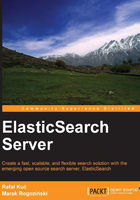
Chapter 1. Getting Started with ElasticSearch Cluster
The first thing we need to do with ElasticSearch is install it. As with many applications, you start with the installation and configuration, usually forgetting about the importance of those steps until something bad happens. In this chapter we will focus quite extensively on this part of ElasticSearch. Be advised that this chapter is not a definitive guide to every configuration option and parameter. Of course, we would like to describe them all, but if we did that we would have to write a book that is twice (or even more) the size of the one you are holding in your hands! In addition to that, ElasticSearch is like all the other software applications available today—it evolves every day and keeps changing. We will cover only what we feel is commonly required, as well as specific functionalities that are sometimes hard to understand or those that are so wide that having them described in a single place would save you some time. By the end of this chapter, you will have learned the following:
- The basic concepts of ElasticSearch
- How to install and configure your Cluster
- Using the ElasticSearch REST API
- How to create an index
- How to configure your mappings
- How to use dynamic mappings
- What a template is and how to use it
- What routing is and how to use it
- How to use index aliasing